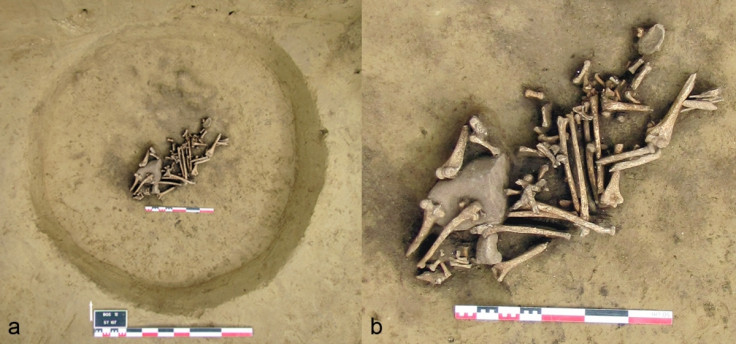6,500-year-old mystery burial pit full of amputated arms points to extreme violence in Neolithic France
A burial pit of severed arms has been discovered in France, with the skeletons of adults and children pointing to extreme violence. The pit, which dates between 4,500 and 3,500 BC was discovered in Bergheim, on the eastern border with Germany.
A study of the findings has been published in the Cambridge journal Antiquity. The pit – dubbed 157 of Bergheim – is an extremely rare find. While other Neolithic pits have been found with collections of skeletons, what makes 157 unique is that it contained a collection amputated upper left arms buried beneath the skeletons of seven individuals.
The pit was 2m deep with a diameter of 1.5m and contained the remains two adult males, one adult female and four children, the youngest of which was between two and four and the oldest between 10 and 13. There was also a cranial fragment of a very young infant, probably less than a year old.

The bodies had been dumped into the pit without care or any attempt to organise them directly above the severed arms. This collection included at least seven portions of left upper limbs and at least five hands. Further analysis of their anatomical connections showed they had been "deposited freshly after amputation".
But the arms did not belong to the individuals above. One of the men – known as individual number seven - had had his arm amputated, but researchers could not determine whether any of the arms below had belonged to him. The rest of the skeletons had both of their arms. "The upper limbs and complete individuals were either deposited simultaneously or over a very short time frame," they wrote.
Study author Fanny Chenal told IBTimes UK the mystery surrounding the burial pit is driven by the little evidence they have to go on. Why the arms had been amputated and arranged in such a way, she said, is "pure speculation", but added: "We know other ethnographic examples where arms correspond to war trophies (Timucua Indians in Florida, for example) but we don't know the motivations of warriors. Ethnography also shows that many anatomical parts (arms, legs, fingers, toes, jaws, teeth, etc.) can be taken for trophies."

She also said it was plausible the pit could contain a family, but they could not say for sure: "We sought to find out by DNA analysis but ancient DNA is unfortunately not preserved in the bones of Bergheim's individuals. Concerning the presence of juveniles in the pit, we can only say that it doesn't go against the hypothesis of armed conflict: a 12-16 years child could be a warrior and younger children could have been victims of raids."
The only thing the archaeologists are sure of is the violence the remains reveal. Fracture and chop marks indicate the upper limbs appear to have been amputated with blows from an axe. It also appears the hands had been deliberately cut into pieces. They concluded that all seven individuals must have been killed – excluding the possibility of starvation or an epidemic.

Researchers also pointed out there were "numerous traces of violence" on individual number seven. He had received severe blows to the head and if he was not already dead at the time this happened, they would have proved fatal. He had fractures on his clavicle and scapula and had sustained damage to his ribs.
They said the killings could have been an intra-group punishment, but they are more likely the result of war. The amputated arms could have been a form of post-mortem mutilation, torture, or for trophies. "The evidence from pit 157 undoubtedly testifies to armed violence, and the amputated arms, most probably trophies, are suggestive of an act of war," the researchers wrote. "The presence of women and children in the pit does not go against this hypothesis: they may have been victims of raids, killed on the scene of the confrontation or captured and executed afterwards."
Chenal added they are now working to better understand the discovery: "What would be amazing for us now is to make similar discoveries to the pit 157 of Bergheim to help us answer all these questions."
© Copyright IBTimes 2025. All rights reserved.






















